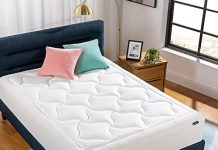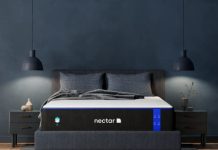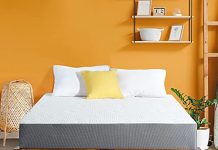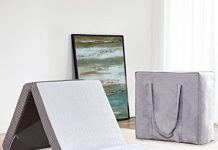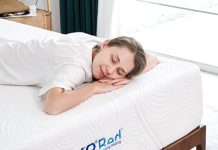Curious about folding mattresses and whether they have springs like a regular mattress? Well, wonder no more! In this article, we’ll explore the world of folding mattresses and uncover the truth about whether or not they contain those beloved springs. So, if you’re on the hunt for a portable bedding solution that still provides the comfort and support of a regular mattress, keep reading to find out all the juicy details.
Review contents
Do Folding Mattresses Have Springs Like A Regular Mattress?
When it comes to choosing a mattress, there are numerous options available in the market. One such option is a folding mattress, which is gaining popularity due to its versatility and convenience. However, if you are accustomed to traditional spring mattresses, you might be wondering if folding mattresses have springs like regular mattresses. In this article, we will explore the construction of folding mattresses and compare them to regular mattresses to shed light on this topic.
Understanding the Construction of Folding Mattresses
Folding mattresses, also known as foldable or roll-up mattresses, are designed with portability and space-saving in mind. These mattresses are typically made up of multiple layers of foam that can be easily folded or rolled up for storage or travel purposes. While they provide a comfortable sleeping surface, folding mattresses differ from regular mattresses in terms of their construction.
Components of a Regular Mattress
Before we delve into the specifics of folding mattresses, let’s explore the components of a regular mattress. Traditional mattresses are typically composed of several layers, including a comfort layer, support layer, and foundation. The comfort layer consists of materials such as foam, latex, or fiberfill, providing cushioning and pressure relief. The support layer, often comprised of springs or coils, contributes to the mattress’s overall firmness and support. Lastly, the foundation layer offers stability and durability to the mattress.
Spring Systems in Regular Mattresses
One of the distinguishing features of regular mattresses is the inclusion of spring systems in their construction. These springs, also known as coils or innersprings, play a vital role in providing support and maintaining the mattress’s shape. They are strategically placed throughout the mattress to distribute body weight evenly and reduce pressure points. Spring systems contribute to the bounce and responsiveness often associated with traditional mattresses.
Types of Springs Used in Regular Mattresses
Regular mattresses feature various types of springs, each offering different levels of support and comfort. The most common types of springs used in regular mattresses are Bonnell coils, offset coils, pocket coils, and continuous coils. Bonnell coils are hourglass-shaped and interconnected, providing a traditional innerspring feel. Offset coils have a similar shape but are hinged together, allowing for better contouring and reduced motion transfer. Pocket coils, on the other hand, are individually encased springs that move independently, providing enhanced support and minimizing partner disturbance. Lastly, continuous coils are made from a single wire, forming rows of S-shaped springs for improved durability and support.
Advantages of Spring Mattresses
Spring mattresses offer several advantages that appeal to a wide range of sleepers. Firstly, the presence of springs in a regular mattress contributes to its excellent support and firmness. The coils help align the spine properly and offer support to areas like the hips, shoulders, and lower back. Additionally, spring mattresses are known for their durability, with the quality of the springs determining the longevity of the mattress. Furthermore, the presence of springs allows for better airflow and temperature regulation, keeping the sleeper cool and comfortable throughout the night.
Disadvantages of Spring Mattresses
While spring mattresses have numerous advantages, they also have some drawbacks to consider. One significant disadvantage is the potential for motion transfer. Due to the interconnectedness of traditional spring systems, movements on one side of the bed can be felt on the other side, which may disrupt sleep for couples sharing a bed. Another drawback is the limited customization options available in spring mattresses. Unlike foam mattresses, which can be easily adjusted to fit individual preferences, spring mattresses have limited flexibility in terms of firmness and contouring.
Alternatives to Springs in Regular Mattresses
In recent years, alternative materials and technologies have emerged to address the limitations of traditional spring mattresses. These alternatives aim to provide improved comfort, support, and motion isolation. Memory foam mattresses, for example, have gained popularity for their ability to contour to the body, relieving pressure points and reducing motion transfer. Latex mattresses are another popular choice, known for their responsiveness, breathability, and hypoallergenic properties. Additionally, hybrid mattresses combine the benefits of both springs and foam, offering the best of both worlds.
Different Types of Folding Mattresses
Now that we have a better understanding of regular mattresses and their spring systems, let’s explore the different types of folding mattresses available in the market. Folding mattresses come in various sizes, including twin, full, queen, and king, catering to different needs and preferences. These mattresses are commonly made up of layers of foam, with variations in the type and density of foam used. Some folding mattresses include additional features such as gel-infused foam for enhanced cooling properties or antimicrobial treatments for increased hygiene.
Construction of Folding Mattresses
Unlike regular mattresses, folding mattresses do not typically include springs in their construction. Instead, they are primarily composed of foam layers, providing a comfortable and supportive surface. These foam layers may consist of memory foam, polyfoam, or a combination of both. The top comfort layer usually incorporates memory foam, which contours to the body and relieves pressure points. The underlying support layer, often made of high-density polyfoam, adds stability and prevents the mattress from sagging.
Folding Mattress vs. Regular Mattress: A Comparison
When comparing folding mattresses to regular mattresses, it is essential to consider your specific needs and preferences. Folding mattresses offer the advantage of portability and ease of storage, making them an excellent choice for those who frequently move or have limited space. Regular mattresses, on the other hand, provide a wider range of options in terms of firmness, support, and customization. Additionally, the presence of spring systems in regular mattresses can contribute to their durability and temperature regulation.
In conclusion, folding mattresses generally do not incorporate springs like regular mattresses. Instead, they are constructed using layers of foam, providing comfort and support. While spring mattresses offer their own advantages in terms of support and durability, folding mattresses offer the advantage of portability and space-saving. Ultimately, the choice between a folding mattress and a regular mattress depends on individual preferences and requirements.



